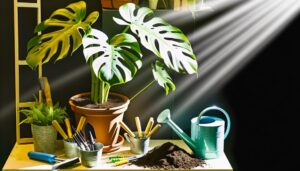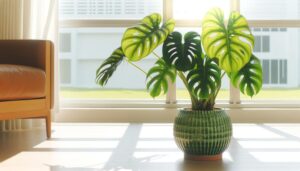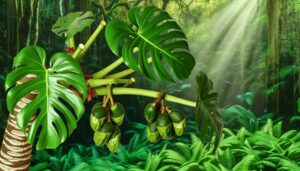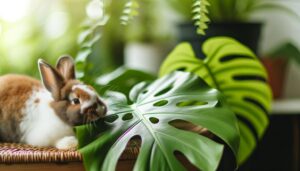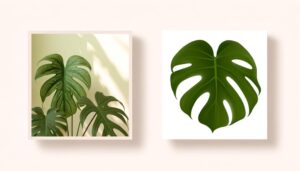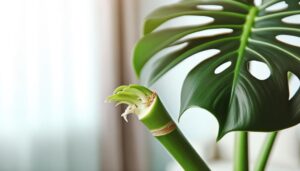Is Monstera Deliciosa the Same as the Elephant Plant?
Monstera deliciosa and the Elephant Plant (Alocasia) belong to different species. Monstera is native to Central America and exhibits climbing growth with aerial roots.
Its leaves have fenestrations and a leathery texture. Alocasia, from the same Araceae family, displays upright growth with arrow-shaped leaves and a rhizomatous root system.
Alocasia's leaves are thinner, velvety, and can exhibit various colors. Monstera prefers indirect light and well-draining soil, while Alocasia thrives in bright, indirect light with consistently moist soil.
Understanding these differences is essential for effective care and will clear up any common misconceptions. Learn more about their unique qualities.
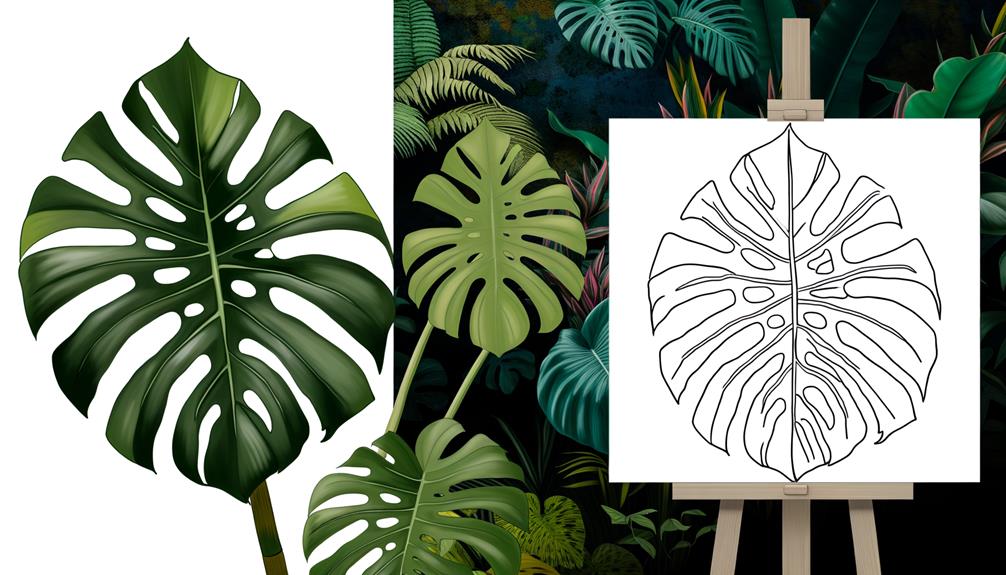
Key Takeaways
- Monstera deliciosa and Elephant Plant (Alocasia) belong to the same Araceae family but are different species.
- Monstera deliciosa has fenestrated leaves, while Elephant Plant has solid, arrow-like leaves.
- Monstera deliciosa grows as a climbing plant with aerial roots; Alocasia grows upright with a tuberous root system.
- Both plants require high humidity and indirect light, but their leaf characteristics and growth habits differ.
- Monstera deliciosa is native to Central America, while Elephant Plant belongs to the Alocasia genus with various origins.
Origins and Background
Monstera deliciosa, native to the tropical rainforests of Central America, is often mistakenly conflated with the Elephant Ear plant, which belongs to the genus Alocasia. Both species thrive in humid environments, but their phylogenetic origins differ markedly.
Monstera deliciosa is part of the Araceae family, specifically the Monstera genus, characterized by its climbing habit and aerial roots. Conversely, Alocasia, also from the Araceae family, is renowned for its large, heart-shaped leaves and tuberous growth.
When you examine their environmental adaptations, you'll see Monstera prefers epiphytic growth on trees, while Alocasia often grows terrestrially in shaded understories. Recognizing these distinctions helps in understanding their unique care requirements and ecological niches.
Leaf Characteristics
When comparing Monstera deliciosa and the Elephant Plant, you'll notice distinct differences in leaf characteristics.
Monstera deliciosa exhibits large, perforated leaves with a glossy texture and vibrant green hue, while the Elephant Plant features broad, heart-shaped leaves with a matte finish and a more muted green color.
These variations in shape, size, texture, and color are key identifiers between the two species.
Shape and Size
The leaves of the Monstera deliciosa exhibit a distinct fenestration pattern, characterized by deep splits and perforations, unlike the uniformly broad and unlobed leaves of the Elephant Plant (Alocasia).
Monstera deliciosa leaves can grow up to 90 cm (35 inches) long and 75 cm (30 inches) wide, presenting a dramatic, lacy appearance. These fenestrations allow light to penetrate through, aiding in the plant's photosynthesis process.
In contrast, Alocasia leaves, often referred to as 'elephant ears,' can reach up to 150 cm (59 inches) in length and 120 cm (47 inches) in width. The shape is typically sagittate, or arrow-like, with a smooth, consistent edge.
Understanding these differences is essential for proper identification and care of each plant species.
Texture and Color
Beyond shape and size, leaf texture and color also offer clear distinctions between Monstera deliciosa and the Elephant Plant (Alocasia). Monstera deliciosa leaves are thick, leathery, and have a glossy surface, indicating a robust cuticle layer. Their color is a rich, deep green, often with lighter variegation.
In contrast, Alocasia leaves are generally thinner, smoother, and have a more velvety texture. They exhibit a striking range of colors, from dark green to deep purple and even black, often with prominent veins. These differences aren't just aesthetic but reflect adaptations to their native environments.
Understanding these variations helps you identify and appreciate the unique qualities of each plant, enhancing your botanical knowledge and gardening skills.
Growth Patterns
Monstera deliciosa exhibits a climbing growth habit, relying on aerial roots to anchor itself to nearby structures, whereas the Elephant Plant, or Alocasia, typically grows upright with large, arrow-shaped leaves.
You'll notice that Monstera deliciosa's aerial roots absorb moisture and nutrients from the air, facilitating vertical growth and spread. In contrast, Alocasia's rhizomatous root system promotes a more grounded, bush-like stature.
Evidence suggests that Monstera can reach impressive heights in its natural habitat, often exceeding 20 feet, while Alocasia generally remains more compact, achieving heights up to 6 feet. This difference in growth patterns directly influences how you might position and support these plants in your space, ensuring ideal growth and health.
Care Requirements
Understanding their distinct growth patterns helps tailor care requirements for Monstera deliciosa and the Elephant Plant, guaranteeing each species thrives in your environment.
Monstera deliciosa prefers indirect sunlight, high humidity, and well-draining soil. Water it when the top inch of soil feels dry, and provide support for its climbing growth.
The Elephant Plant, often Alocasia or Colocasia, demands bright, indirect light and consistently moist soil, especially during active growing seasons. It thrives in high humidity environments and benefits from regular fertilization with a balanced, water-soluble fertilizer.
Monitor both plants for pests like spider mites and aphids, and uphold good air circulation to prevent fungal diseases. Proper care promotes robust growth and reduces the risk of common horticultural issues.
Common Misconceptions
A common misconception is that Monstera deliciosa and the Elephant Plant are the same species, but they belong to entirely different plant families and exhibit distinct morphological characteristics. Monstera deliciosa, part of the Araceae family, showcases fenestrated leaves, while the Elephant Plant, typically from the Araliaceae family, features large, solid leaves. Confusion often arises due to their similar lush appearance.
Here's a comparison table:
| Feature | Monstera deliciosa | Elephant Plant |
|---|---|---|
| Family | Araceae | Araliaceae |
| Leaf Type | Fenestrated | Solid |
| Growth Habit | Climbing vine | Shrub or tree |
Understanding these distinctions clarifies that they are not interchangeable, aiding you in making informed botanical decisions.
Indoor Vs Outdoor Suitability
When deciding between indoor and outdoor cultivation, you must consider the specific environmental requirements and growth behaviors of both Monstera deliciosa and the Elephant Plant. Monstera deliciosa thrives in humid, indirect light conditions typical of indoor environments, while tolerating occasional direct sunlight.
Conversely, the Elephant Plant (Alocasia sp.) requires consistent moisture and prefers shaded outdoor areas but can adapt to indoor settings with ample humidity.
- Light Requirements: Monstera prefers indirect light; Elephant Plant needs partial shade.
- Humidity Levels: Both plants benefit from high humidity but Monstera can tolerate lower levels.
- Temperature Range: Monstera tolerates a broader range (60-80°F), while the Elephant Plant requires warmer conditions (above 65°F).
- Growth Space: Monstera can grow large indoors; Elephant Plant needs more space when grown outdoors.
Understanding these nuances helps you make an informed decision.
Propagation Methods
When propagating Monstera Deliciosa, you'll find the stem cutting technique highly effective due to its simplicity and high success rate.
Air layering steps require you to create a small incision on the stem, apply rooting hormone, and wrap it with moist sphagnum moss.
For soil propagation, make sure the medium is well-draining and rich in organic matter to promote healthy root development.
Stem Cutting Technique
Mastering the stem cutting technique establishes effective propagation of Monstera Deliciosa, providing a reliable method to create new, genetically identical plants. To secure success, follow these steps:
- Healthy Stem Selection: Choose a vigorous stem with no signs of disease or damage.
- Sanitization: Sanitize your tools to prevent pathogen transfer.
- Cutting Placement: Position the cutting in an environment with indirect sunlight and high humidity.
- Root Development: Monitor for root growth, which typically starts within a few weeks.
Select a healthy stem with at least one node and an aerial root, use sanitized pruning shears to make a clean cut below the node, and place the cutting in water or moist soil until roots develop.
This method secures genetic consistency and robust plant development.
Air Layering Steps
Utilize air layering to propagate Monstera Deliciosa by encouraging root development on a still-attached stem, ensuring the plant's continued nourishment during the process. You'll need a sharp knife, sphagnum moss, plastic wrap, and twist ties. Start by making a small incision below a node and wrap it with moist sphagnum moss. Secure the moss with plastic wrap and twist ties to maintain moisture. Roots will develop within a few weeks.
Here's a concise table to guide you:
| Step | Materials Needed | Key Action |
|---|---|---|
| Incision | Sharp knife | Make a small cut below a node |
| Moss Application | Sphagnum moss | Wrap moist moss around incision |
| Securing | Plastic wrap, ties | Secure with plastic and ties |
Monitor the progress and, once roots form, cut and plant the new section.
Soil Propagation Tips
Soil propagation, frequently utilized for Monstera Deliciosa, involves planting stem cuttings directly into a well-draining soil mix to encourage root formation. You'll need to follow specific steps to guarantee success.
First, take a healthy stem cutting with at least one node and a leaf. Dip the cut end in a rooting hormone to stimulate root growth.
Plant the cutting in a pot filled with a soil mix that promotes proper aeration and moisture retention. Keep the soil consistently moist but not waterlogged.
Confirm the soil mix contains perlite or sand for adequate drainage.
Maintain a humid environment to facilitate root development.
Place the pot in indirect sunlight to prevent leaf burn.
Monitor for pests and diseases, treating promptly if observed.
Choosing the Right Plant
When choosing the right plant for your home, contemplating the specific environmental requirements and growth patterns of each species is crucial for ensuring ideal health and longevity.
Monstera deliciosa, for example, thrives in indirect light and high humidity environments, requiring well-draining soil and regular watering.
In contrast, the Elephant Plant, or Alocasia, prefers bright, indirect light and consistently moist, but not waterlogged, soil. Recognizing these differences helps you provide the best possible conditions.
Also, consider your space limitations—Monstera can grow quite large, while Alocasia remains more compact.
Take into account potential allergenic reactions and pet safety, as both plants contain calcium oxalate crystals that can cause irritation.
Making an informed choice based on these criteria will improve your plant's well-being and your home environment.
Conclusion
To wrap up, while Monstera deliciosa and the Elephant Ear plant are distinct species, they share some similarities that often lead to confusion.
Notably, Monstera deliciosa can grow leaves up to 3 feet long, illustrating its impressive size.
By understanding their unique requirements and characteristics, you'll be better equipped to care for each plant effectively.
For indoor horticulturists, both plants offer striking foliage and robust growth, making them excellent choices for enhancing your living space.

